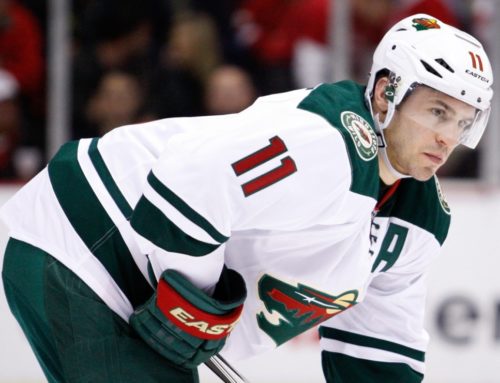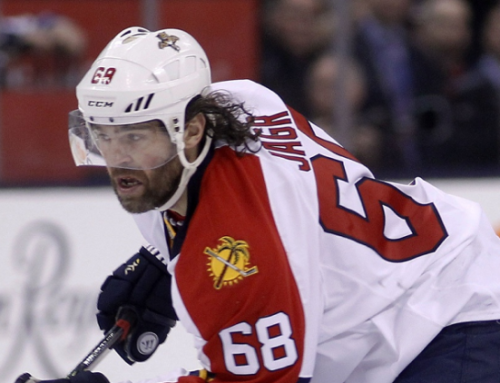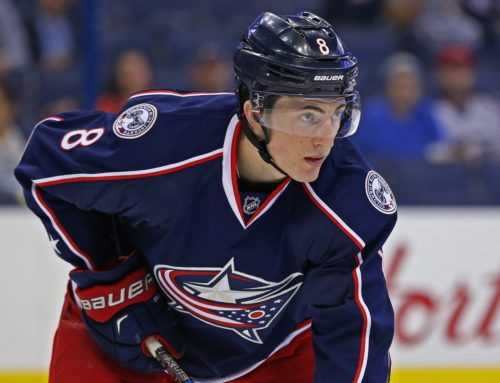The Contrarian – Optics of it All
Demetri Fragopoulos
2016-08-28

Should the recent Panthers/Coyotes trade force changes to salary cap rules?
Earlier this week the Florida Panthers and Arizona Coyotes decided to help each other with a trade. A couple of draft picks going to the Panthers in exchange for Dave Bolland and Lawson Crouse.
This deal makes Ken Warren of the Ottawa Citizen feel that this somehow tarnishes the rules of the salary cap system.
Coyotes-Panthers trade not exactly great news for Bettman and Co. https://t.co/AkCQpSx3el pic.twitter.com/0k5O9qfJCW
— Ottawa Citizen (@OttawaCitizen) August 26, 2016
He states, “There are some bad optics here, particularly for an Arizona organization that the NHL has repeatedly propped up financially,” and continues, “The latest trade continues a trend over the past few seasons that has seen the Coyotes load up on young prospects in exchange for becoming a dumping ground for bad contracts.”
We all know about Pavel Datsyuk and Chris Pronger. If we forgot, Warren does the math for us, “Add it up and the Coyotes will be paying an eyebrow-raising $11.575 million next season for a trio of players who may never play a game for them.”
Gasp!
“In the big picture, though, you’ve got to wonder how well some rival NHL teams are stomaching the Coyotes’ moves,” says Warren.
His concluding line, “We’re guessing it’s not exactly what Gary Bettman had in mind when he talked about competitive balance after the current CBA was signed.”
But it was and it still is.
I am going to dissect these thoughts.
One thing that I find odd with the article is that Warren places a negative tone on Arizona but a positive on Florida.
The Panthers got rid of Bolland’s contract and young prospect Crouse. They make more room for future contracts without losing much. However, they basically sold their former first round pick for a little over six million dollars, per season over the next three seasons (add Bolland’s $5.5 million to Crouse’s $0.8 million).
Florida’s roster is deep enough now, so they decided to switch from holding on to cap filler contracts like Marc Savard (trade to New Jersey this summer). This is what Arizona will be aspiring for in the near future and they are doing it also by collecting a series of early-round selections.
Instead of trying to outbid the large markets, the Coyotes are using their leverage of having lots of cap space to assist other teams when they run into cap trouble.
How is that any different from stockpiling on defensemen and then swapping a prospect for an established forward? Space within your team salary structure is a commodity and should be viewed that way by all teams.
In his article, Warren does admit that both teams are playing within the rules and that other teams in the league have made similar moves in the past.
So to answer one of his earlier questions, these other teams are wishing that they had the opportunity to make similar deals.
What about the extent of the cap space money being warehoused?
I have done a rough calculation of last season’s cap, looking specifically at those players who were on injured reserve, cap recapture and any overage penalties placed on a team.
Montreal, Florida, and Toronto had salaries that topped over $10 million dollars in those three categories alone. It does not include any retained salaries, buyouts, or buried contracts.
My point being that Arizona’s "eyebrow-raising" value this season is nothing new and hardly the extreme amount that is suggested by Warren.
I'm torn on Coyotes-Panthers deal. Is it about smart $ management by Coyotes or is something terribly wrong with NHL salary cap system?
— Ken Warren (@Citizenkwarren) August 25, 2016
Well, what about the fact that Arizona had been in financial distress and needed help from the league? That is also part of the rules within the section regarding revenue sharing. While not quite what the NFL does, at least there is such a mechanism in the NHL to assist its have-not teams.
The last time the Coyotes averaged more than 14,000 in attendance was the 2008-09 season. In between they had a few playoff runs, but attendance never rose above that mark.
If taking on some dead-cap-salaries means they pick up some young talent that will develop to play alongside their current core, then their history of asking for handouts will be short lived. Everyone in the league will be better for it too.
In his own words, “The Coyotes are now a team to watch on the ice, boasting an impressive corps of young players, including Dylan Strome, Max Domi and Anthony Duclair.” Therefore, I fail to see how their maneuverings are such a bad thing to the league. It will bring competitive balance.
That leaves us with the question of what Bettman thinks. The focus in Warren’s article is slightly skewed to thinking that what Arizona has done is boarding on circumvention to illegal, but why should we perceive it this manner and in this way?
What Bettman would have wanted was for all teams to spend below the salary cap levels. Each team restrain their spending and leave some breathing room, yet we all know that teams, especially the ones that make lots of money, are greedy and want to flex their muscles by spending right up to the very top of the cap. They do this because they want to win.
There is no way Bettman could ever stop clubs from spending money because it would be collusion to holding player salaries down.
What the league cannot do by explicit rules or behind-closed-door agreements, the system has provided a mechanism for teams with limited budgets to capitalize on their empty space.
However, it is up to each team to maximize and leverage that dead space and turn it into young players with potential that end up being not only affordable but also importantly reinvigorating.
Look at your fantasy league’s rules and investigate where you can push the limits. There could be legitimate ways you can improve your team right at your fingertips, but you choose to only do what has become comfortable and normal.
It is not as sexy as drafting the next Connor McDavid, but you will not care when you are crowned champion of your league.
Optically, that would be a good thing.
3 Comments
Leave A Comment
You must be logged in to post a comment.





 BOS
BOS OTT
OTT CBJ
CBJ CAR
CAR MTL
MTL DET
DET PHI
PHI WSH
WSH FLA
FLA TOR
TOR WPG
WPG SEA
SEA VAN
VAN CGY
CGY VGK
VGK CHI
CHI EDM
EDM COL
COL S.J
S.J NYI
NYI

I agree. I don’t see any basis for saying there’s something “wrong” with the system. There is no moral judgment here, there’s no right or wrong. It is simply what is allowed in the context of the rules. While there is no doubt that ANY system will have its loopholes, this does allow smaller market teams to compete by capturing younger, cheaper players.
Datsyuk will receive ZERO dollars, Pronger only receives 575K & if the information I have been able to find is correct Bolland’s contract is insured so Arizona is only on the hook for approximately 20% of it, 1.1 million.
Warren should try to dig up some facts & try to stop misrepresenting the truth. What 11.575 million is Arizona paying? Even if Bolland’s contract isn’t insurable & my source isn’t the NHL or NHLPA so unreliable, Arizona is only on the hook for Bolland’s 5.5 & Prongers .575. That’s only 6.075.
This isn’t your old Phoenix Coyotes; losing 30 million plus annually, this is the Arizona Coyotes who in the last season currently reported lost 4.5 million; 2014-15.
http://www.statista.com/statistics/193744/operating-income-of-national-hockey-league-teams-in-2010/
The whole CBA structure has numerous flaws not the least of which is not just using real dollars against the cap in the year paid. I have no issue with teams paying others to take their dead contracts. It helps the teams less fortunate financially. I wish cash could be included in deals like the old days. It’s away for the have teams to revenue share with the have nots.
The next lock out, which is coming will again claw back some of the players wealth. Go look at that chart I posted. 8 teams lost money in 2014-15 including the TB who went to the Stanley Cup final & averaged 19 thousand fans per game. Another 8 barely made 5 mil. The top 3 teams in the NHL by operating income; Montreal, NYR & Tor, make essentially as much as the rest of the league combined. Thankfully revenue sharing will again be improved as well.
I admit it’s the dog days of summer but doesn’t Warren have better things to do than sensationalize a column & misrepresent the truth?
Thoughts from the bench.
And the money they’ve saved by taking on the $6.075M and stockpiling young talent is substantially more! If you replace two youngsters on ELC’s with two veterans at $4M each, that brings them well above water, since it’s multiple years. I didn’t see where Warren said anything about how much they paid out, but I am indeed annoyed by the tendency of journalists today to sensationalize a question that isn’t even up for discussion.